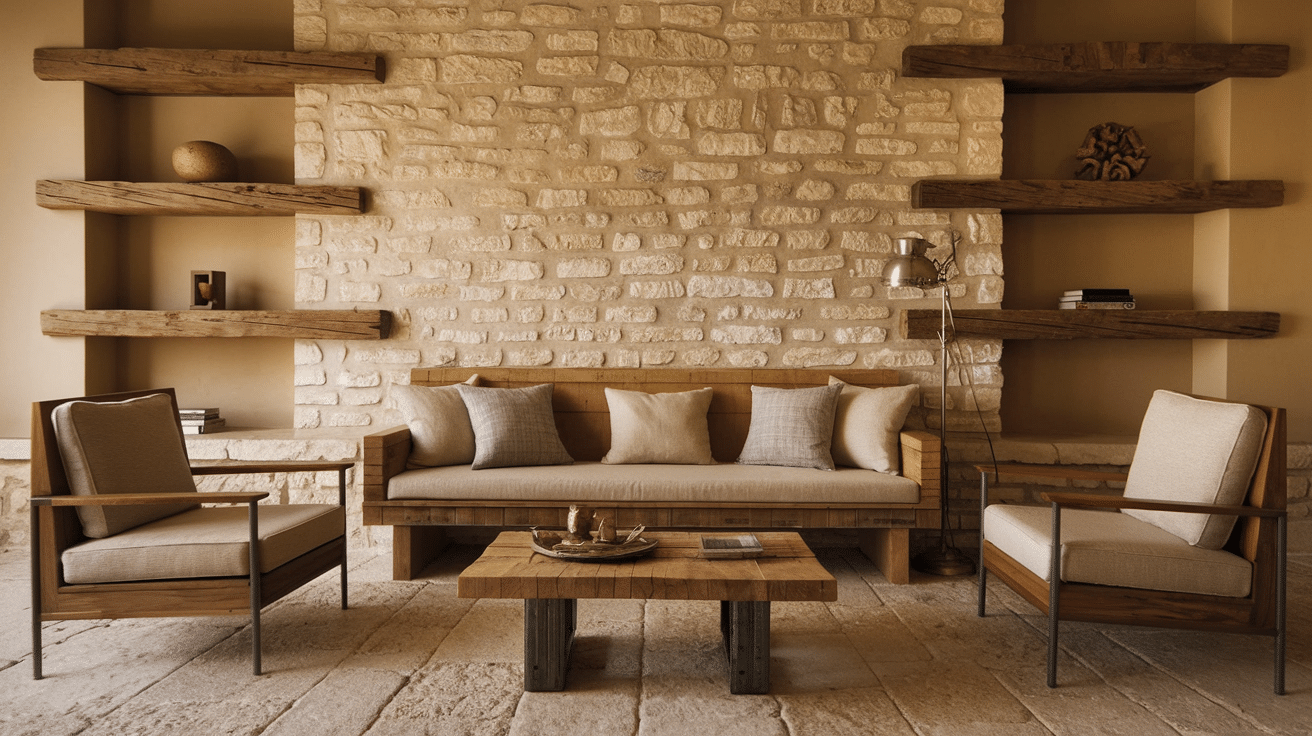Have you ever wanted to live in a timeless Italian farmhouse? A place full of natural beauty and charming rustic decor? Many people do. The good news is that you can bring this style to your own home.
Think about mixing rustic warmth with modern simplicity. This blend creates a home that feels both welcoming and stylish. Modern rustic Italian design does exactly this.
This design style combines old traditions with clean, simple lines. It offers the comfort of rustic elements with the clean look of modern spaces.
In this blog, we’ll show you how this design style can change your space. You’ll learn how to create a warm, lasting, and charming home with Italian flair. We’ll share tips for making your rooms feel both cozy and fresh at the same time.
Why does Modern Rustic Italian Design feel Like Home?
Modern rustic Italian design blends old-world charm with fresh, simple styles. This mix uses natural materials, clean shapes, and calm colors to create spaces that feel both old and new.
The magic of this style comes from balance. Rough wood beams might sit above smooth marble counters. Stone walls might stand beside plain white furniture. This design approach offers three main benefits:
- It stays in style for years, saving you from constant updates
- It feels warm and welcoming to guests and family alike
- It often uses natural, lasting materials that help the planet
The look brings the cozy feeling of an Italian villa into modern homes. Wood, stone, and metal blend with simpler, cleaner lines, creating spaces that feel lived-in yet fresh.
People love this style because it feels real. Unlike passing trends, modern rustic Italian design connects to history while looking toward the future. It’s a style that lets you live with both comfort and class.
The Key Elements of Modern Rustic Italian Interior Design
These four key elements will help you create an authentic, modern, Italian rustic interior.
1. Neutral and Warm Color Palette
Warm whites, beige, earthy browns, and muted terracotta tones create a peaceful setting in your home. These soft, natural hues make spaces feel cozy and welcoming without being busy.
Your walls and main pieces should stick to neutral tones to highlight the textures that make the Italian rustic style special. Small touches of mustard yellow or olive green can add life to the room while maintaining its calm feel.
2. Natural Materials that Speak to the Soul
Stone, wood, and terracotta form the core of this look, with each material showing its natural marks. These raw elements connect your home to the Italian countryside and bring warmth to modern spaces.
Iron and brass accents balance the rougher textures with touches of refined beauty. The mix of textures makes these spaces feel rich and lived-in, with each material adding depth through its unique feel.
3. Clean Lines and Functional Furniture
Modern rustic Italian design balances old and new. A rough wooden dining table paired with sleek chairs shows how these styles work together. This mix keeps spaces from feeling like museums while still honoring Italian design history.
Choose furniture with clean lines in neutral colors for a fresh look against natural backgrounds. Good flow and balance in your furniture placement helps create spaces that feel both modern and timeless.
4. Embracing Rustic Italian Structures
Highlight structural elements like vaulted ceilings and stone walls to add character. These features tell a story and connect your home to Italian building traditions.
Wooden beams and arches create a timeless atmosphere that frames your living spaces. When possible, keep these elements visible and make them focal points that showcase the beauty of Italian architectural design.
Incorporating the Modern Rustic Italian Look
Recast your space with these practical styling approaches that capture an Italian rustic design with a modern twist.
1. Materials and Textures Matter
Combine rough stone walls with smooth plaster finishes or raw wood with polished surfaces. This contrast creates visual depth while maintaining harmony. Layer different textures like jute rugs under wooden tables or wool throws over linen couches to add warmth to every room.
Styling tips:
- Match stone countertops with wooden cabinets
- Use iron fixtures against soft wall textures
- Select materials with visible grain patterns or subtle variations
- Incorporate at least three different textures in each room
2. Furniture Blending Old and New
Mix timeless wooden pieces with modern functional items. A hand-crafted table paired with simple chairs creates perfect balance. Place antique cabinets near modern sofas, finding common elements in wood tones or shapes that help different pieces work together.
Styling tips:
- Keep proportions similar when mixing furniture styles
- Choose pieces that serve dual purposes
- Balance heavy rustic items with substantial modern ones
- Look for weathered woods that contrast with clean metal finishes
3. The Art of Layering with Minimalism
Add cotton, linen, and wool textiles in neutral colors to soften harder elements. Simple linen curtains and wool cushions bring comfort to wooden furniture. Select a few special pieces—an antique mirror, handmade pottery, or vintage painting—rather than cluttering every surface.
Styling tips:
- Choose textural interest over busy patterns
- Limit decorative objects to 3-5 per surface
- Select one statement piece per room
- Use natural materials for all accessories
- Keep the color palette limited to 3-4 harmonious tones
The Timeless Appeal of Rustic Italian Architecture
The architectural features of Italian rustic design create spaces of timeless beauty. Vaulted ceilings bring a sense of grandeur while still feeling homey and welcoming.
Stone walls connect the interior to its natural surroundings, telling stories through their texture and color. Wooden beams showcase traditional craftsmanship and add warmth to any room. These elements work together to create spaces that feel authentic and full of character.
When updating rustic Italian structures, the most successful renovations honor the original features. Preserving stone flooring, exposed wooden beams, and terracotta tiles maintains the building’s soul.
Modern updates can enhance these elements rather than hide them. Simple lighting can highlight textured walls, while contemporary furniture can provide contrast to ancient stonework.
Budget-Friendly Modern Italian Rustic Design Tips

Tip 1: Shop thrift stores for solid wood pieces with good bones that can be refinished. A worn wooden chest works beautifully with a clean-lined sofa.
Tip 2: Support local artisans selling small-batch items like pottery or textiles. These add authentic character at lower prices than imported pieces.
Tip 3: Create lime-washed walls with inexpensive paint and lime powder for texture and depth, similar to Italian plaster finishes.
Tip 4: Update old furniture with chalk paint and light sanding for a weathered look. This beginner-friendly technique does not require special skills.
Tip 5: Collect natural elements like branches, stones, and dried herbs to display in simple vessels as free, authentic decor.
Conclusion
Creating a modern Italian rustic home isn’t about copying a postcard—it’s about capturing a feeling. By embracing natural materials like stone and wood, you’re building spaces that feel authentic and lived-in.
The neutral color palette creates a perfect backdrop, while the mix of textures adds visual interest that draws people in. The beauty of this style lies in thoughtful contrasts—rough stone against smooth plaster, weathered wood beside sleek metal.
Each element tells part of a story that feels both timeless and current. Remember that balance is key, whether you’re working with architectural features, furniture pieces, or simple decorative touches.
By following these guidelines and making them your own, you’ll create spaces that welcome, comfort, and inspire—truly bringing a piece of Italy into your everyday life.
Frequently Asked Questions (FAQs)
What is the Modern Rustic Interior Design Style?
Modern rustic interior design combines natural materials with clean lines. It uses wood, stone, and neutral colors to create warm, simple spaces that feel both cozy and uncluttered.
What Colors are Modern Rustic?
Modern rustic colors are mostly neutrals like white, beige, brown, and gray. Earth tones and natural wood hues are common. Occasional blacks and dark greens add depth to the palette.












